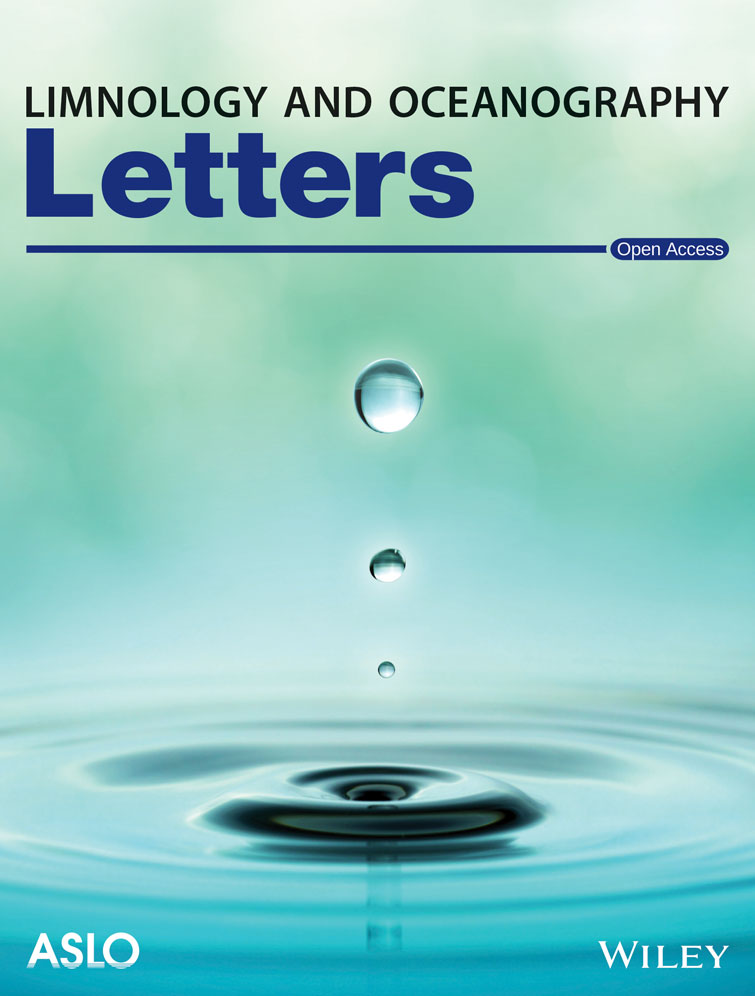Salinity is diagnostic of maximum potential chlorophyll and phytoplankton community structure in an Eastern Boundary Upwelling System
IF 5
2区 地球科学
Q1 LIMNOLOGY
引用次数: 0
Abstract
Coastal upwelling ecosystems associated with strong physical stirring exhibit significant mesoscale hydrographic and biological patchiness. Though many studies have found broad correlations between hydrographic properties (e.g., temperature and salinity) and phytoplankton biomass, we lack a detailed understanding of the mechanisms underlying these correlations. Here, using observational data from coastal waters in the California Current System, we demonstrate that the maximum observed chlorophyll in a water parcel increases with salinity—a conservative water‐mass tracer. This relationship arises from the correlations of vertical salinity and sub‐euphotic zone nitrate profiles. This allows us to define the maximum potential chlorophyll as a function of salinity, and thus nitrate. We show that variations in salinity explain patterns in phytoplankton community structure, and discuss how growth, grazing, and light and micronutrient limitation can generate chlorophyll values below the maximum potential. Our mechanistic explanation provides a novel framework for diagnosing biological patchiness solely through salinity observations.盐度是东边界上升流系统最大潜在叶绿素和浮游植物群落结构的诊断指标
与强物理搅拌相关的沿海上升流生态系统表现出显著的中尺度水文和生物斑块性。尽管许多研究发现了水文特性(如温度和盐度)与浮游植物生物量之间的广泛相关性,但我们对这些相关性背后的机制缺乏详细的了解。在这里,利用加利福尼亚洋流系统沿海水域的观测数据,我们证明了在水包中观测到的最大叶绿素随着盐度(一种保守的水质量示踪剂)的增加而增加。这种关系源于垂直盐度和亚亮带硝酸盐剖面的相关性。这使我们能够将叶绿素的最大潜能定义为盐度和硝酸盐的函数。我们发现盐度的变化解释了浮游植物群落结构的模式,并讨论了生长、放牧、光照和微量元素限制如何使叶绿素值低于最大潜力。我们的机制解释为仅通过盐度观测诊断生物斑块提供了一个新的框架。
本文章由计算机程序翻译,如有差异,请以英文原文为准。
求助全文
约1分钟内获得全文
求助全文
来源期刊

Limnology and Oceanography Letters
Multiple-
CiteScore
10.00
自引率
3.80%
发文量
63
审稿时长
25 weeks
期刊介绍:
Limnology and Oceanography Letters (LO-Letters) serves as a platform for communicating the latest innovative and trend-setting research in the aquatic sciences. Manuscripts submitted to LO-Letters are expected to present high-impact, cutting-edge results, discoveries, or conceptual developments across all areas of limnology and oceanography, including their integration. Selection criteria for manuscripts include their broad relevance to the field, strong empirical and conceptual foundations, succinct and elegant conclusions, and potential to advance knowledge in aquatic sciences.
 求助内容:
求助内容: 应助结果提醒方式:
应助结果提醒方式:


